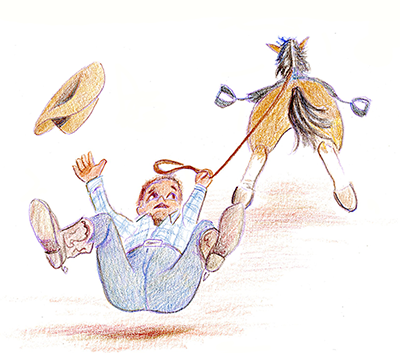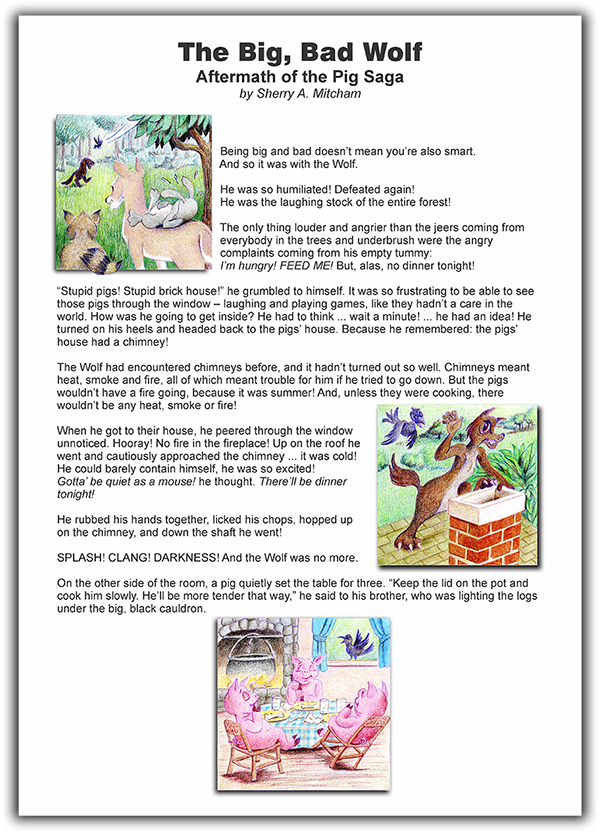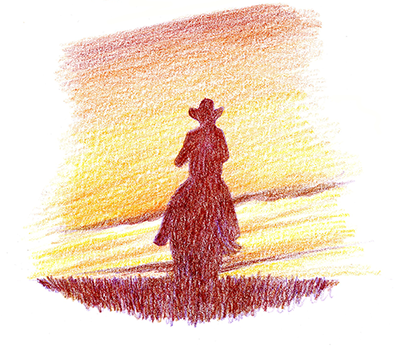- [email protected]
- Fayetteville, Georgia
Picture This
A Riding Lesson for
Pony-Owning Picture Book Drawers

There’s an air of romance and mystique associated with being a creative. No matter if you compose, write, paint, draw, sculpt or whatever, the average person on the street is in awe of your gift. How on earth do you do what you do?
They have lofty visions of the lone artist in the solitude of his studio, composing, writing and painting as inspiration and brilliance flow like water onto pages and canvases in rivers of words and colors …
But bundled with the gift comes a pony.
Oops.
There might be some good reasons why that studio door is shut!
Like on days when we're getting dragged through the dust, hanging on for dear life, because we have no clue where to start, when to stop, where to find the motivation, groping for ideas, wondering what’s next, confused about what might work, trying to remember has worked ... well, so much for mystique!
But heads-up, all you illustrators out there ... forget the Oops! ... your pony is your very best friend! The only difference between riding high and getting dragged through the dust is knowing what questions to ask.
Because when you ask the right questions, you'll begin to get answers.
Getting answers means getting choices. Now instead of trying to figure out what to do, you'll be deciding which solution will work best.
Now your focus is narrowing and you're getting clearer mental images of what's needed.
The more clear those mental images are, the more focused you get. Motivation skyrockets and you're off!
Now, instead of eating dust, you're riding high!
Let me show you how it works ...
1. First, we'll need a story
The little tale below is one I made up for my article, Submitting to Publishers. I needed something very short and simple to use as an example there, and we can use it here, too:
The Big, Bad Wolf
Aftermath of the Pig Saga
by Sherry A. Mitcham
Being big and bad doesn’t mean you’re also smart. And so it was with the Wolf.
He was so humiliated! Defeated again! He was the laughing stock of the entire forest!
The only thing louder and angrier than the jeers coming from everybody in the trees and underbrush were the angry complaints coming from his empty tummy: I’m hungry! FEED ME! But, alas, no dinner tonight!
“Stupid pigs! Stupid brick house!” he grumbled to himself. It was so frustrating to be able to see those pigs through the window – laughing and playing games, like they hadn’t a care in the world. How was he going to get inside? He had to think ... wait a minute! ... he had an idea! He turned on his heels and headed back to the pigs’ house. Because he remembered: the pigs’ house had a chimney!
The Wolf had encountered chimneys before, and it hadn’t turned out so well. Chimneys meant heat, smoke and fire, all of which meant trouble for him if he tried to go down. But the pigs wouldn’t have a fire going, because it was summer! And, unless they were cooking, there wouldn’t be any heat, smoke or fire!
When he got to their house, he peered through the window unnoticed. Hooray! No fire in the fireplace! Up on the roof he went and cautiously approached the chimney ... it was cold! He could barely contain himself, he was so excited! Gotta’ be quiet as a mouse! he thought. There’ll be dinner tonight!
He rubbed his hands together, licked his chops, hopped up on the chimney, and down the shaft he went!
SPLASH! CLANG! DARKNESS! And the Wolf was no more.
On the other side of the room, a pig quietly set the table for three. “Keep the lid on the pot and cook him slowly. He’ll be more tender that way,” he said to his brother, who was lighting the logs under the big, black cauldron.
“Yes!” agreed the third brother. “Make him tender ... Yum! There’ll be dinner tonight!”
2. Now, ask yourself some questions
A. What is the goal or the end product?
We need to know the parameters and constraints that will guide us ...
Is this going to be a book?
A web page or a magazine article?
Are we making posters to be held up during a public reading?
Are we responsible for layout and typesetting, or pictures only?The answers to this first question will give us necesary information like:
- sizes
- how many finished drawings we need
- if we need to consider what a printer or a web person will need
- who will get the final art? Does it need to be framable? Or if we just need a few drawings, can we just draw them all on one board and scan them together?Answers for A
For this demo, let's say it's for a kids' on-line magazine. They want 2-4 drawings to add to the copy to make the web page look nice and more fun to read.
They don't need to be large, so we'll just draw them at a nice size that will be easy to draw and still fit together on one board, making scanning the finished art faster and easier at the end.
Because it's going on a webpage which will be viewed on different size phone screens, we'll keep the drawings more vertical or square, which will work better than images that are very wide.B. Who is the target audience?
Answer for B
We'll need to check the actual website to see what ages they cater to. Based on that and the way the story is written, the readers are most likely younger elementary students, say 6 to 8 year olds.
This is important to know, because the ending to this story is a little gruesome. Older kids might like a scary, dark ending and we could make the drawings deliciously macabre, but for younger readers, we'll need to soften it a bit and perhaps even add some humor. More of "the bad wolf got his comeuppance" and less of "the bad wolf is DEAD"! We don't want to be giving kids nightmares!
C. What points of the story could the illustrations highlight?
Answers for C
- well, for starters, he is THE big, bad wolf of classic fairy tales
- he's embarrassed, mad and hungry
- all of the other animals in the forest are laughing at him
- he gets what he thinks is a brilliant idea to solve his hunger and get back at the pigs
- he has a most eventful trip down the chimney and into the pot
- the pigs at the end are interesting ... not rattled at all ... smug? Nonchalant? Hmmm ....D. What is not written in the text that could be added to the illustrations and would make the pictures even better?
Answers for D
- when I think about "laughing" animals, that makes me think of a crow's caw
- when I think of crows, I remember times when I've seen smaller birds dive-bombing crows who got too close to nests. The other animals would maintain a safe distance from the wolf even when they are laughing at him, but I can picture a crow laughing and dive-bombing him
- because crows fly, he could even be up on the roof when the wolf climbs up and into the chimney
- a fun-loving crow could provide the bit of humor we need to lighten up the feel of a scary wolf and his gruesome end for young readers
3. Now do some brainstorming with pencil and paper
This isn't about finished, perfect art. These are "what if ..." sketches:
- what if you try a different perspective?
- what if you add that crow dive-bombing him?
- what if you forget the crow?
- what if you show those smug pigs setting the table, getting ready?
- what if you show them all stuffed and happy after their meal is eaten?

4. Choose the rough ideas you like and ask some more questions
- what will the wolf look like?
- what will the pigs look like?
- will you put clothes on the wolf and the pigs?
- how about the other animals?
- what about that pesky crow?
5. Let the drawing begin!
Now, based on your own answers to all those questions, you've got a road map for proceeding.
Keep the drawings rough if you need to experiment some more. Sometimes you'll get an unexpected and terrific brainstorm ... and that's great! If you just sit at the beginning and try to come up with great ideas, they will most likely elude you. But when you take it step by step like this, you're inviting great ideas to evolve and bubble up in your brain in unexpected moments.
Don't rush the process. Slow and steady forward movement is the best way to go. There's always room for a detour or two along the way, and you'll be less likely to get stuck at some point wondering, What's next?

When your sketches are right, finish them up with whatever mediums or techniques you like to work in.
I won't show all the steps for the color rendering. If you'd like to see up-close how to work in colored pencil, check out From Brain to Paper, It LIVES!!, or the Planning Your Book series.
Perhaps I should've put clothes on those pigs ... I think Porky Pig got in trouble with censors once ... no pants!! Heads-up ... drawing for kids is fraught with danger!
And here's what our completed web page might look like:

The toughest part of an illustrator's job is drawing from pure imagination. Especially when illustrating picture books where you might need to draw 10-20 illustrations, where elements and characters need to match on all the pages.
For the greatest chance of success, make a plan like the one above and follow it carefully.
Everybody works differently, and you may or may not like the steps I go through, so tweak it where you need to and make it your own. Or come up with a plan that's a better fit for how you work. The point is ... make a plan.
Without a plan, you can indeed get hopelessly bogged down in the process and feel like you're out of control on a wild horse ride ... hence my "pony" metaphor.
But a pony under control can take you amazing places you couldn't otherwise go.
Then you can ride that pony off into the sunset and astound the world with your talent and brilliance ... which is way more fun than getting dragged through the dust!
